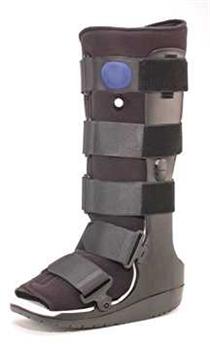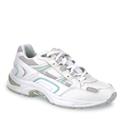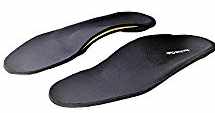Home remedies for ankle sprains
If not treated correctly, ankle sprains can cause chronic ankle pain and instability. We recommend that you always have an ankle sprain evaluated and treated by a specialist. If you are in the Seattle area and have sprained your ankle, contact us for an appointment. If you absolutely cannot see a doctor right away, follow the 4-step plan below.
Step 1: IMMOBILIZATION AND BRACING
The cornerstone of treatment of a lateral ankle sprain is the proper use of immobilization devices that allow early weightbearing. Bearing weight on your ankle will encourage healing of torn ends of ligament and restore the ankle to its most stable position.
 We provide our patients with a plan of immobilization that starts with the use of a removable casts for two weeks. This prevents motion so that the ligaments can heal properly. Our recommended removable cast is the Tall Ossur Air Walker.
We provide our patients with a plan of immobilization that starts with the use of a removable casts for two weeks. This prevents motion so that the ligaments can heal properly. Our recommended removable cast is the Tall Ossur Air Walker.
 About two weeks later (depending on how well a patient is doing) we move patients into an ankle brace such Ossur Exoform Ankle Brace. They wear this for the next 2 – 4 weeks to allow continuing healing of the ankle ligaments.
About two weeks later (depending on how well a patient is doing) we move patients into an ankle brace such Ossur Exoform Ankle Brace. They wear this for the next 2 – 4 weeks to allow continuing healing of the ankle ligaments.
Step 2: BALANCE AND PROPRIOCEPTION
![]() Restoration of balance and posture has been shown to be the most important aspect of preventing future ankle sprains. Although many patients are immobilized properly until pain and swelling subside, they will go on to develop symptoms of instability because redeveloping balance in the ankle is ignored. Patients will start with simple exercises and work up to doing their exercises on a wobble board.
Restoration of balance and posture has been shown to be the most important aspect of preventing future ankle sprains. Although many patients are immobilized properly until pain and swelling subside, they will go on to develop symptoms of instability because redeveloping balance in the ankle is ignored. Patients will start with simple exercises and work up to doing their exercises on a wobble board.
Step 3: FOOT ORTHOTICS
There is considerable research that demonstrates that many of those patients with chronic instability of the ankle also have instability of the joint directly beneath the ankle (the sub-talar joint). This is the joint at which your foot rolls in and out (or pronates and supinates).1 Properly prescribed custom functional orthotics act to stabilize the sub-talar joint and therefore help prevent ankle sprains.
The most successful rehabilitation occurs when you are able to wear your orthoses before you start back to activity without your ankle brace. Evaluation for the orthotics should therefore take place about 3 weeks after the injury — when normal walking is likely to have returned and swelling to have decreased substantially.
If you are unable to get custom orthotics for any reason, we recommend the use of the most stabilizing prefabricated orthotic you can find. Of the prefabricated orthotics we have reviewed for ankle sprain, our recommended arch support is the FootChair Podiatrist Designed Adjustable Arch Orthotic. This has the best arch height we have found due to an adjustable arch via pads that can be inserted under the cover.
Step 4: SHOES
 Shoes that offer exceptional all-around support will help prevent future ankle sprains. We will provide you with recommendations of appropriate shoes for your foot type and a list of shoe stores with personnel trained in proper fitting. Look for stable shoes with room for an orthotic. We often recommend Orthofeet Shoes for Women and Orthofeet Shoes for Men.
Shoes that offer exceptional all-around support will help prevent future ankle sprains. We will provide you with recommendations of appropriate shoes for your foot type and a list of shoe stores with personnel trained in proper fitting. Look for stable shoes with room for an orthotic. We often recommend Orthofeet Shoes for Women and Orthofeet Shoes for Men.
Ankle sprains that are not treated correctly can lead to long-term problems. If you have sprained your ankle or are experiencing ankle symptoms call today for an evaluation in our convenient Seattle office.





